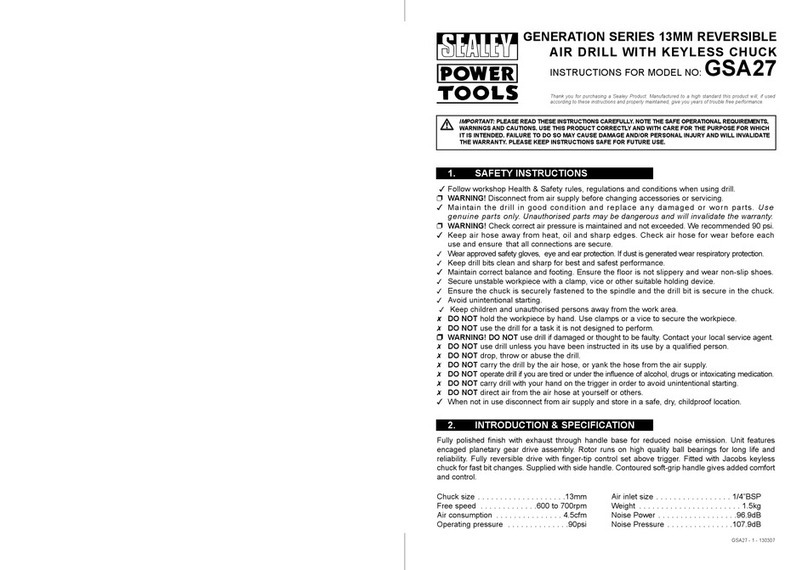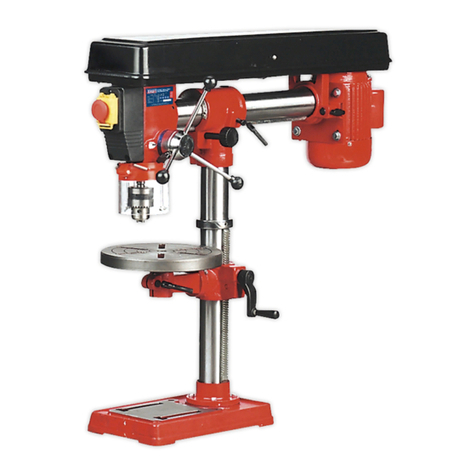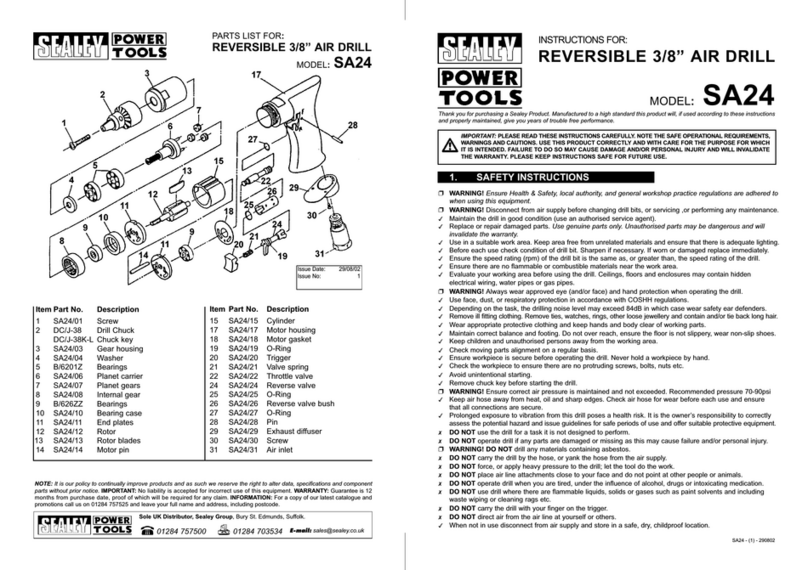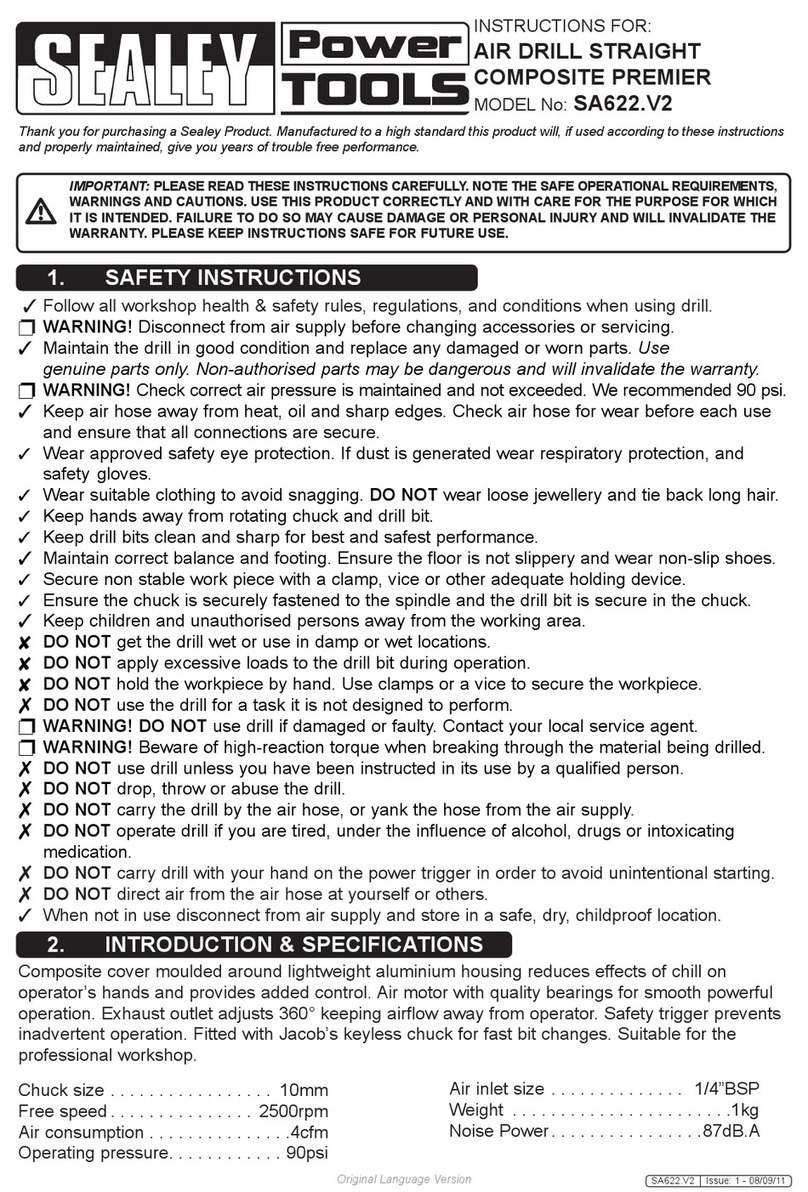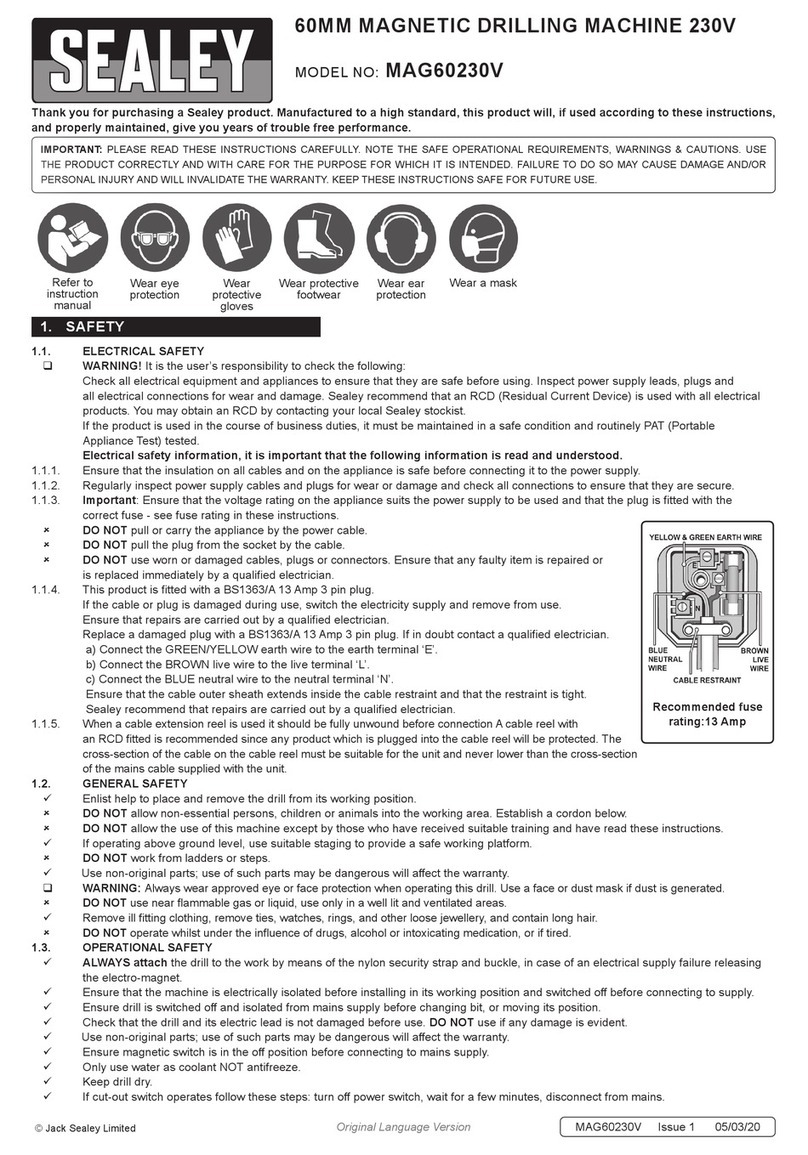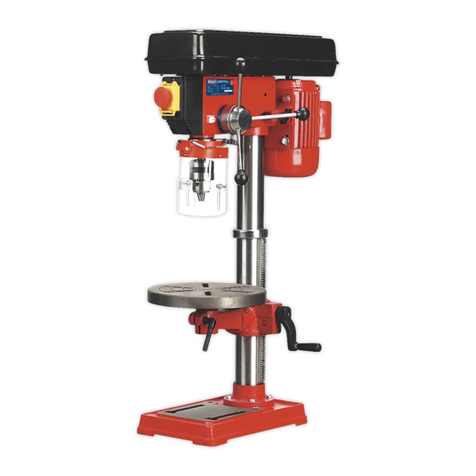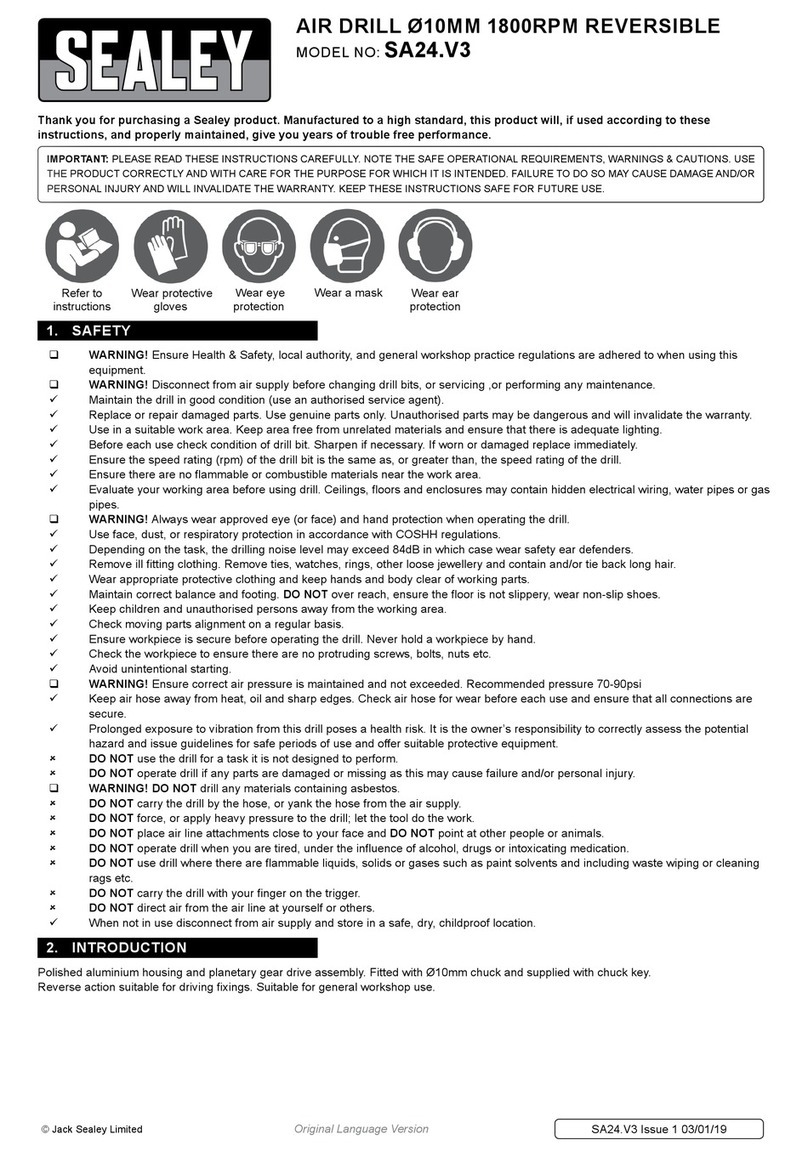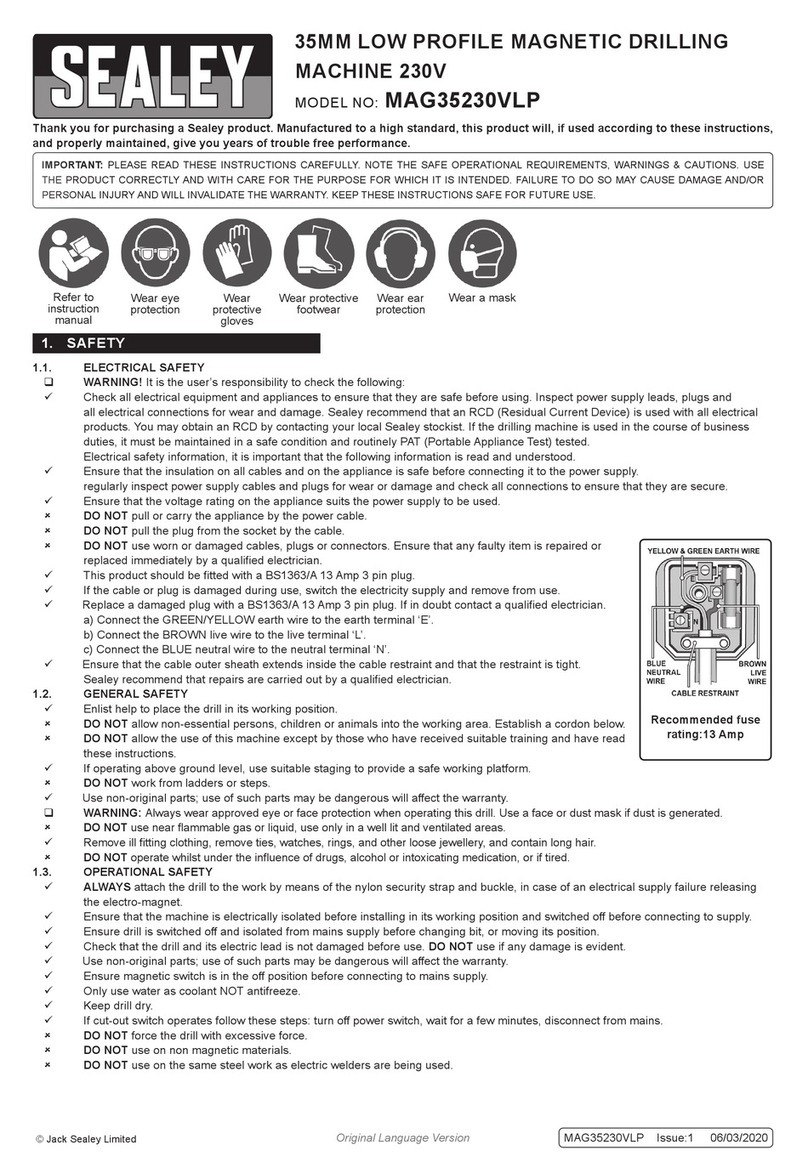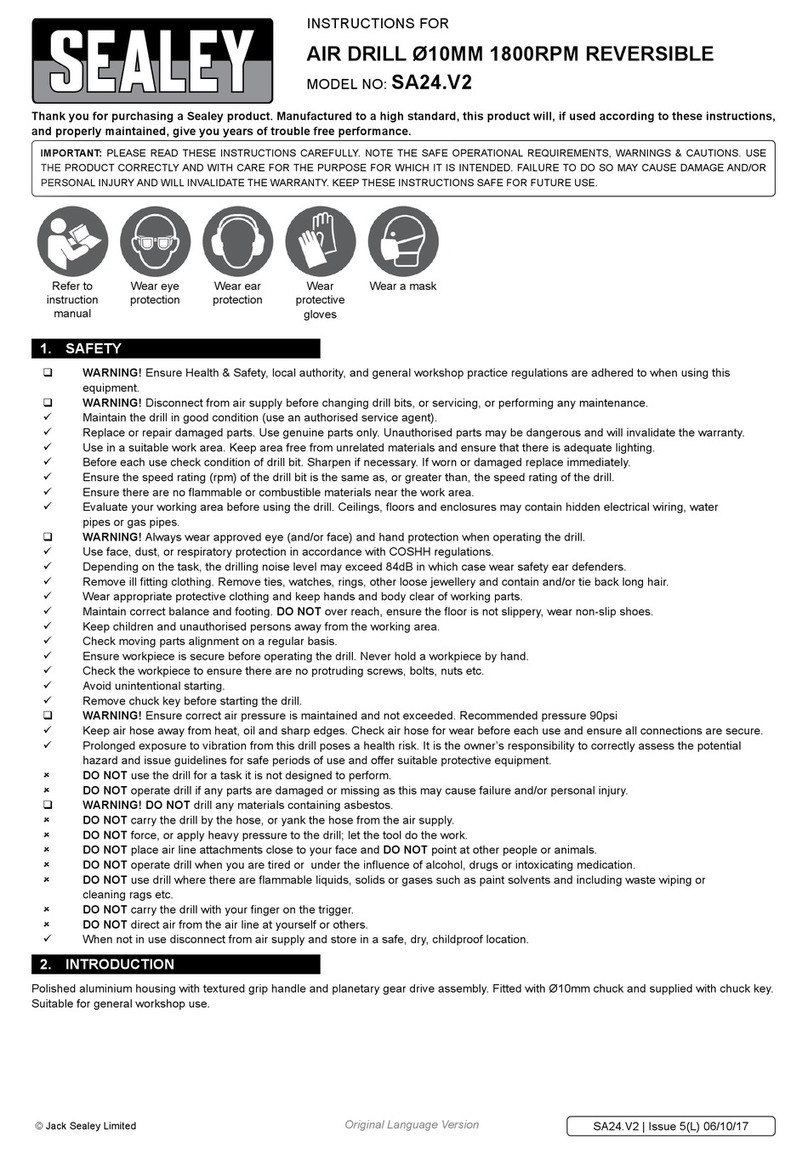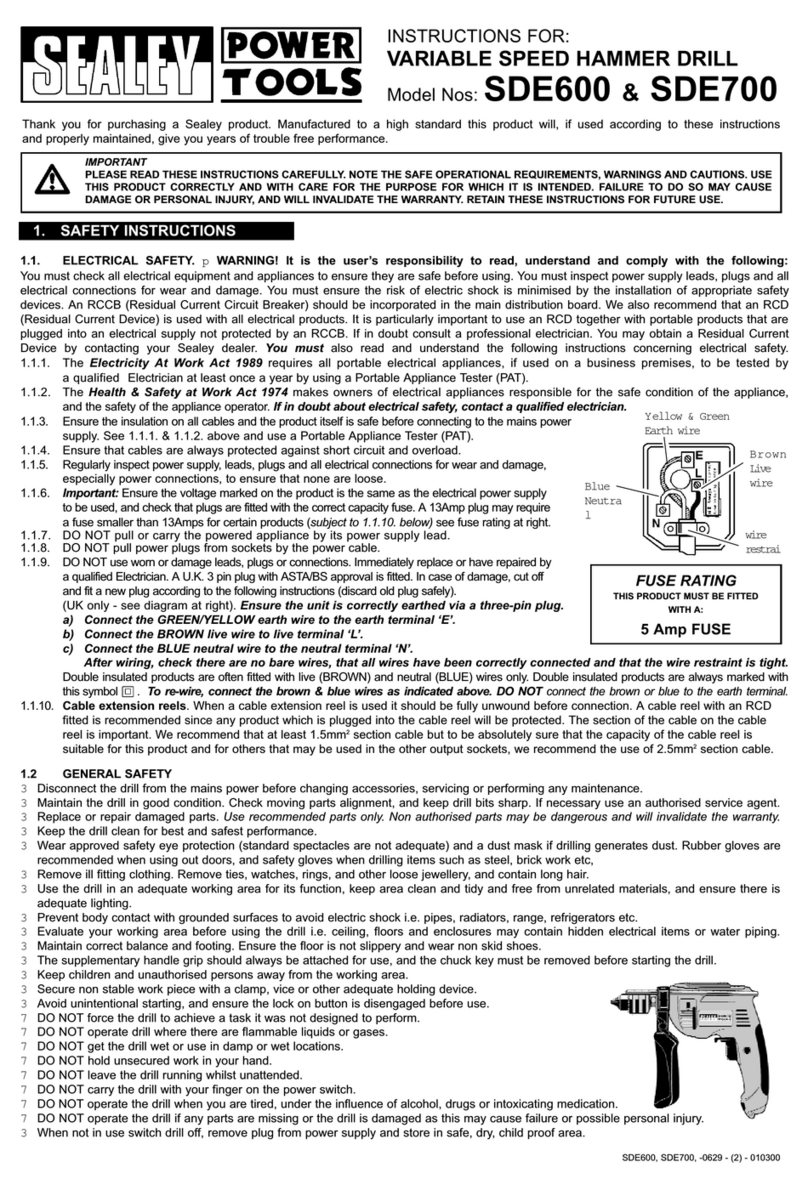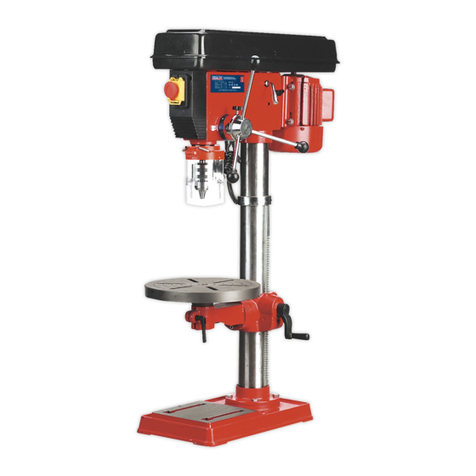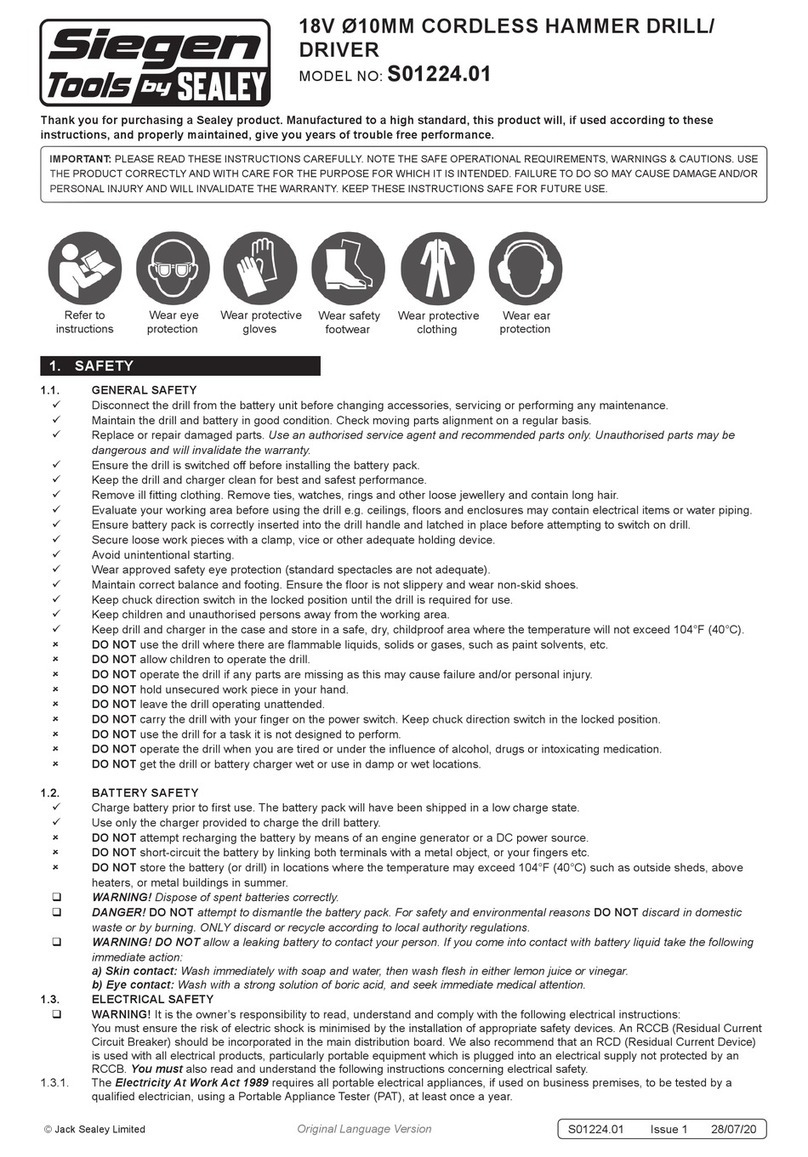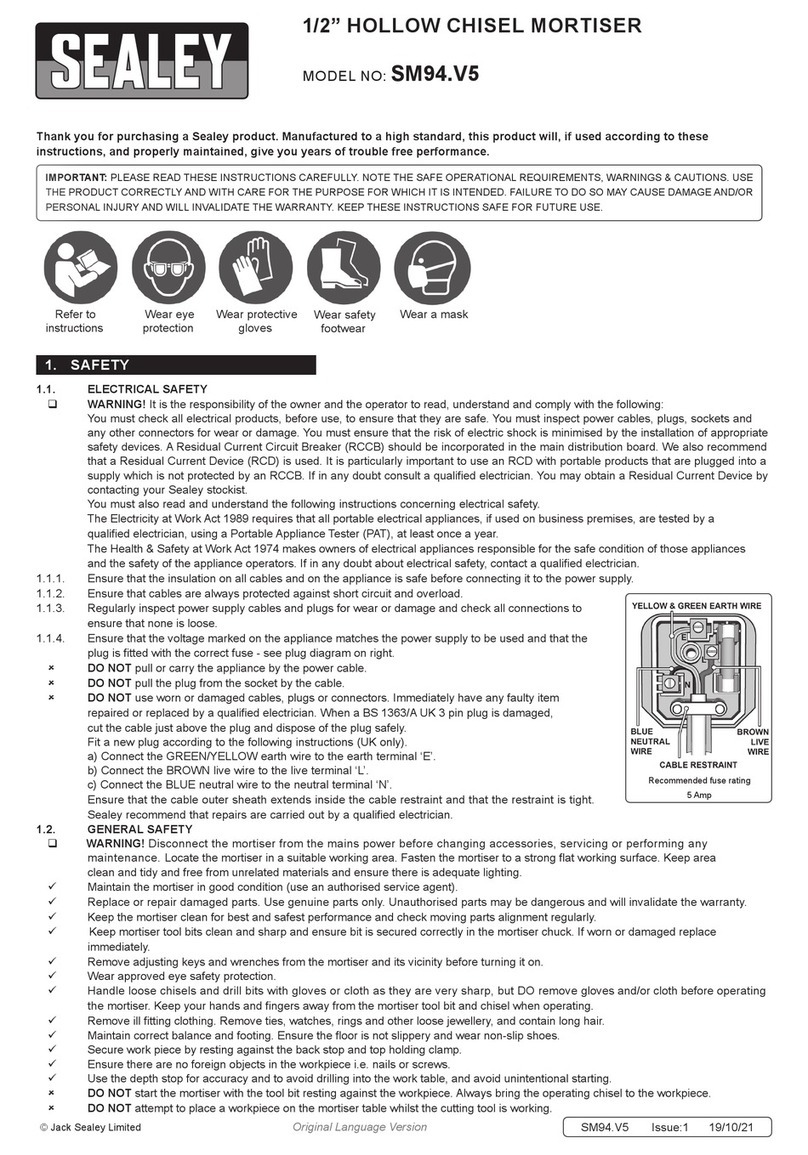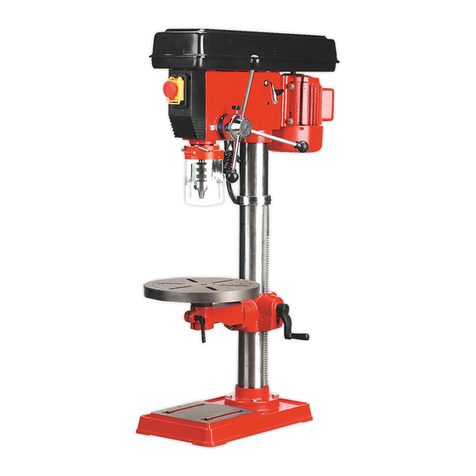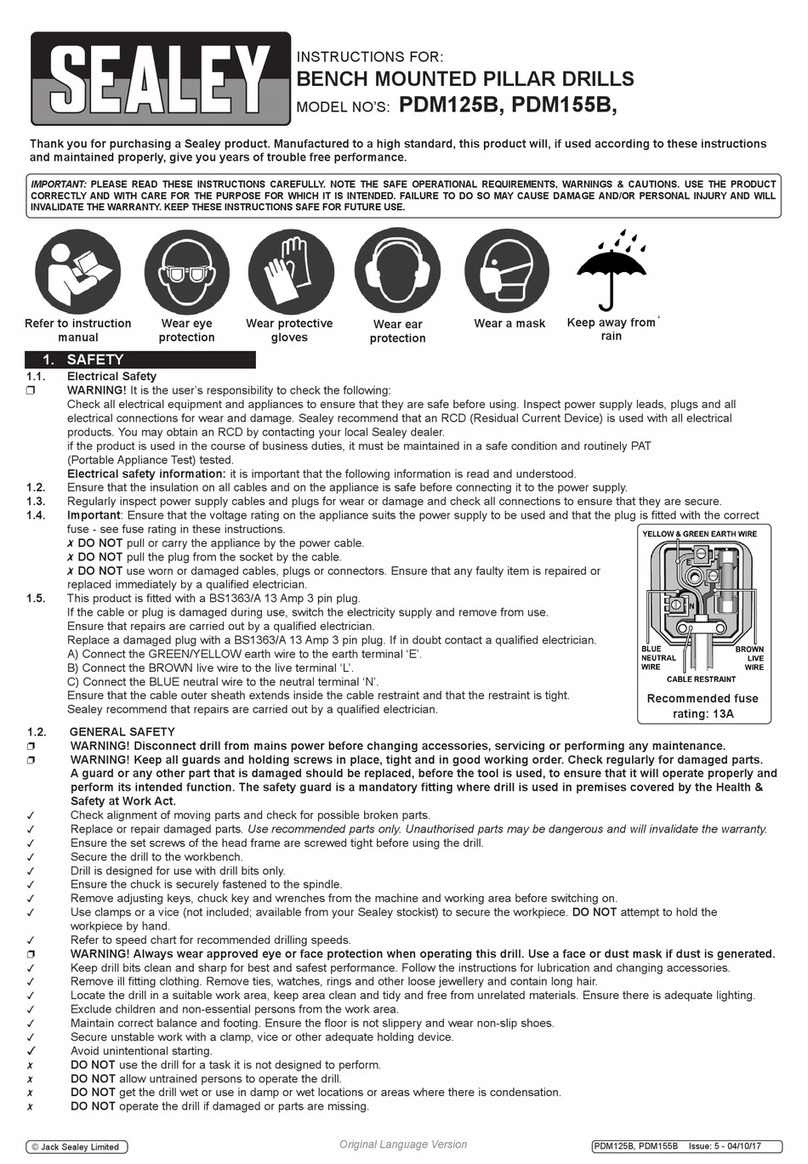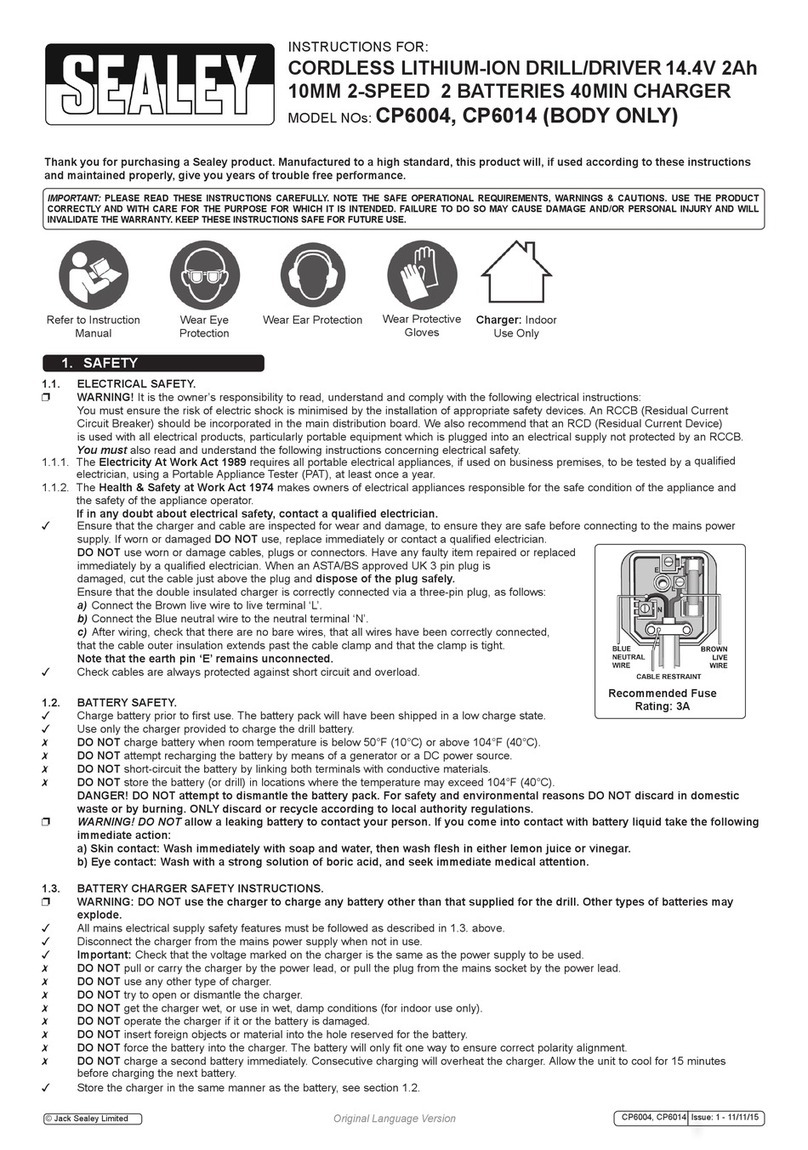
3.2.3. Torque setting (Fig 1. 2 & 3).
Torque is the amount of turning force applied by the drill. Torque setting 1 on dial (fig.1.3) is lowest and will apply the least effort to the final turns of
a screw, i.e. torque becomes progressively greater with increased setting numbers, up to 3 the drill symbol being the highest setting. The combination of
variable speed and torque gives maximum drilling/screw-driving efficiency. The lower torque settings are suitable for driving small screws and drilling with
fine drill bits to prevent shearing of the screws/bits. Screws/bits of larger diameter permit higher torque settings to be used.
3.2.4. As a screw or bolt driver
1. Lock appropriate tool bit in the chuck. Select the shortest length bit possible to ensure greatest control.
2. A small pilot hole may be required to ease the path of the screw, especially in hard woods.
3. Set a low torque to begin with, gradually increasing the torque if necessary.
4. To remove screws, bolts, etc., press direction switch in from the left for reverse (anti-clockwise).
5. When finished, remove the bit from the chuck, clean drill and bit and store in the carry case.
3.2.5. Hammer action (fig 1.4). (Symbol at opposite side to torque 1).
p WARNING! DO NOT use the hammer action with metal/wood drill bits as these may shatter. Use only with masonry bits.
The hammer action, with a masonry drill bit, is used to assist drilling into concrete, stone and masonry. To use, turn the torque adjuster (fig1.3) to hammer function
(fig.1.4). To disengage the hammer function turn the adjuster back to another appropriate torque setting. Note: DO NOT shift to hammer when the drill is
running as this may damage the machine.
3.2. DRILLING INSTRUCTIONS (Ensure you have read, understood and comply with all the Section 1 safety instructions)
p
p
p
WARNING! always wear approved safety glasses when drilling.
3.2.1. Preparation
1. Open the chuck (fig 1.1) by holding the rear collar and turn the front chuck collar, and Insert the drill bit fully into chuck and tighten.
2. Check the drill to ensure the direction switch (fig.1.5) is in the mid (lock) position, and push battery in the drill base and check it is locked in place.
3. Push direction switch (5) to the left (as you hold drill and view it from the rear), for clockwise rotation,band push the switch to the right for anti-clockwise
rotation (withdrawing drill bits, undoing screws/nuts/bolts). NOTE: Do not change direction while drill is running.
3.2.2. Drill Speed
1. Speed of the drill is controlled by the electronic variable speed switch (5). Press the switch gently for a slow speed and progressively increase the pressure
on the switch to produce correspondingly higher speeds (try before starting to drill).
2. The Maximum revolutions may also be adjusted by changing the two speed switch (fig 1.4). See specifications for details.
NOTE: DO NOT change mechanical speed whilst operating the drill.
3.2.6. Drilling. p
p
p
WARNING! Ensure that you have read and understood Section 1 safety instructions before using the drill.
1. If the material to be drilled is loose it should be secured in a vice or with clamps to keep it from turning as the drill bit rotates.
2. When drilling metals, use a light oil on the drill bit to keep it from overheating. Oil will prolong bit life and improve the drilling action.
3. For hard, smooth surfaces use a centre punch to mark desired hole location. This will prevent bit from slipping as your start to drill.
4. A pilot hole may be necessary to assist the final size drill through the work piece. Lock a pilot drill (smaller size drill than the required hole size) in the
chuck. Follow steps 5 to 9 below and drill a pilot hole at the centre punch mark where final hole is to be drilled. Insert the final sized bit. Hold drill firmly, place
the tip of the bit in the pilot hole and depress the trigger.
5. Hold drill firmly and place the bit tip on the point to be drilled.
6. Depress the trigger to start drill. Move the drill bit into the work piece applying only enough pressure to keep the bit cutting. DO NOT force or apply
side pressure to elongate the hole.
7. Regularly withdraw the drill bit from the hole in order to clear cuttings.
8. Ease the pressure of drilling when the bit is about to break through the far side of the workpiece.
p
p
p
WARNING! prepared for drill binding or break through. When such occurs the bit has a tendency to grab and drill may kick in opposite
direction which could cause loss of control. If you are not prepared, this loss of control may result in damage and/or personal injury.
9. If the bit jams in the work piece or if the drill stalls, release the trigger switch immediately. Place the drill in reverse to assist release of the bit.
10. After a long period of continuous operation, allow the drill to run with no load and at maximum speed to cool the motor.
p
p
p
WARNING! drill bits can become very hot during use. Allow to cool or hold with a cloth for removal.
When finished, remove bit from chuck, clean drill, clean, and, if necessary, re-sharpen bit and store in a safe, dry, childproof area.
4. MAINTENANCE
Cleaning
Keep the drill ventilation slots clean and free from obstructions. If available, blow compressed air into the vents to clear any accumulated
dust (safety goggles must be warn when undertaking this process).
Keep the outer case of the drill clean and free from grease. DO NOT wash with water or use solvents or abrasives.
01284 757500
E-mail:
sales@sealey.co.uk
01284 703534
Sole UK Distributor
Sealey Group,
Bury St. Edmunds, Suffolk.
NOTE: It is our policy to continually improve products and as such we reserve the right to alter data, specifications and component parts without prior notice.
IMPORTANT: No responsibility is accepted for incorrect use of this product. WARRANTY: Guarantee is 12 months from purchase date, proof of which will
be required for any claim. INFORMATION: For a copy of our latest catalogue, call us on 01284 757525 and leave your full name and address, including post code.
3.1.9. When charge is complete, remove battery pack ready for use. Place the charger unit in the carry case.
RAPID CHARGING...............
CHARGE COMPLETED.......
TEMPERATURE FAULT.......
DEFECTIVE BATTERY.........
GREEN LED
RED LED
GREEN LED
GREEN LED
STAND BY
.............................
Light blink rate example
Alarm sound Bi...Bi.
Alarm sound Bi...Bi...
fig. 3
Declaration of Conformity We, the sole importer into the UK, declare that the productslisted below are in conformity with the following EEC standards and directives
The construction filesfor these products are held by the Manufacturer and may be inspected on request by contacting
Jack Sealey Ltd For Jack Sealey Ltd.
Sole importer into the UK
of Sealey as Power Products
1st August 1999
Signed by Mark Sweetman
Cordless Battery Drill Model CP9722VHK &
Battery Charger Model CPX12/NTC
73/23/EEC LV Directive (S.I. 1994/3260)
89/336/EEC EMC Directive
CP99722VHK - 0016 - (1) - 010899
